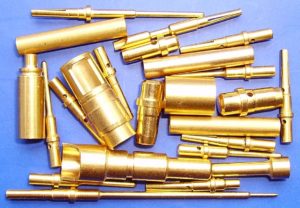You might know that gold is a noble metal, whose electron shells are completely filled and unlikely to be attracted to other elements. You might know that old contacts provoke less signal noise than other metals, but did you know that contacting tin with gold will corrode the gold over time? Mixing tin contacts with gold-plated contacts can compromise the connection altogether. Put connector materials on your list of things to troubleshoot when you’ve exhausted everything else.
Tin (Sn) is another common metal used for making connections and makes a good contact in the right conditions. Materials science touches on electronics in several areas, but a lesser-known issue is in what materials are acceptable for long-term, reliable contacts and solder joints. Cheaply manufactured electronics might save on cost but end up costing severely in the long-run. One common — and cheap — material is tin. The highest standard for electronics in materials is gold (Au).

The Advantages of Gold
There are several advantages to gold connectors. Being noble, gold is less susceptible to corrosion in harsh environments than tin and can be mated and unmated for more cycles. Non-noble metals can oxidize and self-coat with what amounts to an insulator. Gold makes a contact with lower resistance than other metals, with better conductivity. Tin is more susceptible to noise on a signal line than gold, so gold is preferable in low voltage analog circuits, especially in environments that create noise in contacts (e.g., environments that introduce noise, for which contacts can introduce signal noise through vibration).
Tin Contacts are Cost-Effective — but Tricky
Connectors with a pitch of less than 1 mm should not be un-annealed, pure tin, either, because “whiskers” can grow between the contacts. Whiskers, or small hairs, can form perpendicular to the metal itself and cause short circuits with neighboring metal. In high-frequency circuits, whiskers can act like antennas. Annealing, coatings, lubricants, and metal alloys can mitigate whiskering. Gold is less susceptible to whiskering, but can still create them, although of much smaller size. For a long time, lead (Pb) was introduced into solder to reduce the chance of whiskers. However, electronics waste that introduced unacceptable levels of lead (and other dangerous elements) into the environment, leading to the Restriction of Hazardous Substances (RoHS). RoHS restricts substances “that are hazardous to the environment, and pollute landfills, and are dangerous in terms of occupational exposure during manufacturing and recycling.”
Barring the use of gold, palladium nickel is a better contact material than tin. Fretting corrosion is corrosion that is induced by oscillation or movement as well as environmental elements. IMC formation is the formation of intermetallic compound layers that can occur between solder joints and metal layers, compromising reliability.
Molex, a well-respected connector manufacturer, has resources on understanding the physics of connectors and materials used. As an unidentified “physics guru” at Molex stated, “As a safety factor, if tin-to-tin is used, I recommend using nickel underplate and a lubricant to reduce the impact of oxidation, fretting corrosion and IMC formation…. In summary, my first recommendation is to use gold-to-gold. Tin-to-tin may work but needs to be thoroughly tested for fretting corrosion, oxidation and IMC formation. Gold-to-tin is not recommended as it is well know[n] that the reliability risk is greatly increased when these dissimilar metals are mated.”
The Tin Commandments
Tin and tin alloys can be used, as they are cost-effective, but only with certain guidelines in mind. An old, but good document produced by AMP, Inc. back in the day, lists them as “The Tin Commandments” as follows:
- Tin coated contacts should be mechanically stable in the mated condition.
- Tin coated contacts need at least 100 grams contact normal force.
- Tin coated contacts need lubrication.
- Tin coating is not recommended for continuous service at high temperatures.
- The choice of plated, reflowed, hot air leveled, or hot tin dipped coatings does not strongly affect the electrical performance of tin or tin alloy coated contacts.
- Electroplated tin coatings should be at least 100 micro inches
- Mating tin coated contacts to gold-coated contacts is not recommended.
- Sliding or wiping action during contact engagement is recommended with tin coated contacts.
- Tin coated contacts should not be used to make or break current.
- Tin coated contacts can be used under dry circuit or low-level conditions.
Read more about gold and tin in electronics from Molex’s Gold or Tin versus Gold and Tin? and for an in-depth explanation of The Tin Commandments, a PDF originally by AMP, Incorporated and presented by TE Connectivity.

Tin sliver zinc nikal